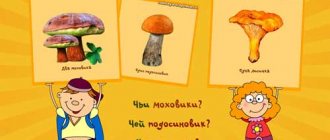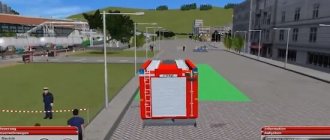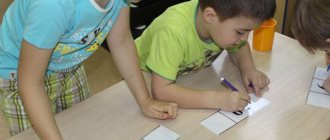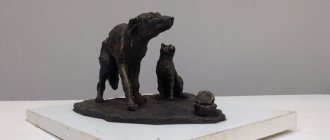"Don't play with fire"
Using examples of active and educational games, you can show preschoolers that games with matches, lighters and open fire are very dangerous. One of these could be the game “Cross it out - it’s dangerous!” Its essence is that cards with objects are written or attached on the board. Children need to cross out those that, if handled carelessly, can cause a fire.
For your information! Another active game on the theme “don’t play with fire” is “Dragon”. One “dragon” is selected, and the rest of the children dance around it and say: “We won’t have fires, the dragon won’t scare us.” When a sleeping dragon wakes up, it waves red ribbons (flames). Those who are touched by the ribbon leave the circle.
Rules of behavior in a physical education lesson
Summary of organized fire safety activities. Preparatory group
Summary of organized activities on fire safety for children of senior preschool age “YOUNG FIREFIGHTERS”
Goal: to develop in children the basics of fire safety, skills of conscious, safe behavior, to create conditions for assimilation and consolidation of children’s knowledge about fire safety rules. Objectives: • to form the concept of “fire safety” in children; • consolidate knowledge about the causes of fire; • develop basic skills and abilities in behavior in the event of a fire; • fostering mutual assistance, friendly attitude towards each other, pride in people of this profession; • activation of motor activity, development of physical qualities: agility, speed, courage; • development of the vestibular apparatus, coordination of movements. Place of organized activity: gym. Type Intellectual and entertaining. Equipment used: Multimedia projector, computer, music, memorable prizes, handouts: 2 sets of cards, posters, 2 telephones, a chest, 2 flannelographs, magnets, an image of a house and garage, buckets, hoops, modules, cones. Preliminary work: 1. Reading works: V. Galchenko “Fire is invisible.”
E. Permyak “From the fire to the cauldron.” S. Marshak “Fire”. 2. Familiarization with the fire shield of the preschool educational institution and the fire extinguishing equipment placed on it. 3. Educational conversation at stand 01. 4. Virtual excursion to the fire department. 5. Dividing children into teams by drawing lots, choosing team captains. Progress of the lesson:
I. Organizational moment. Educator: Children, what a wonderful day today! I am glad to welcome you to our hall. Take a deep breath, exhale. Take each other's hands, smile at each other. I wish you all a good mood. May this day bring us a lot of new and interesting things. Educator: You know that a long time ago a man made fire. Fire is a helper. It faithfully serves people in everyday life and at work. But fire can also be an enemy. Playing with fire is dangerous. Improper use of electrical appliances, gas equipment and even sparklers can lead to big trouble. Today we will once again remember the fire safety rules, I invite you to take part in the competition game. I would like to introduce you to our guest. Meet Alexander Anatolyevich Gerasimov, Senior Inspector of the Supervisory Activities Department for the Kungursky City District and the Kungursky Municipal District of the 13th Supervisory Activities Department for the Kungursky City District, Kungursky, Berezovsky and Kishertsky Districts of the Main Directorate of the Ministry of Emergency Situations of Russia for the Perm Territory. Fireman: Hello guys! Today I will test your knowledge of fire safety and help you understand some difficult situations. Educator: And also, Alexander Anatolyevich will determine the winners of our game today. And the most active and inquisitive ones will take an excursion to the fire department of the city of Kungur. Well, are you ready? Captains, introduce your teams. II. Work on the topic: Greeting the teams: 1. Team “Sparkles”.
Motto: “If you pick up matches, you immediately become dangerous, because the fire that lives in it will bring a lot of trouble to everyone.”
2. Team “Ogonki”.
Motto: “Don’t light the fire yourself, And don’t let others: Even a tiny flame is not far from the fire.”
Educator: Let's greet each other with applause. Before each game, players warm up. Here we will do a warm-up. I will ask riddles to the teams in turn. If a team cannot give the correct answer, then the opponents have a chance to get an extra point. Warm-up: Riddles:
1. What, just touched, turns a house into firewood?
(Fire) 2. On the roof - with a pillar, in the hut - with a tablecloth. (Smoke) 3. This is a cramped, cramped house: A hundred sisters are huddled in it. And any of the sisters can flare up like a fire! (Box of matches) 4. Hisses and gets angry, afraid of water. With a tongue, but does not bark. Without teeth, but bites. (Fire) 5. A hundred fires are kept in a small barn. (Box of matches) 6. He eats everything - he doesn’t get enough, but he drinks - he dies. (Fire) 7. Small, remote, but brings big trouble. (Spark) 8. I saw smoke - don’t yawn, call us quickly! (Firemen) 9. Little me won’t turn you into fire. (Spark) 10. Where people are careless with fire, there will definitely be fire. (Fire) Educator: Well done guys! You did an excellent job. And now it’s time to move on to the main tasks. Competition No. 1: “Question and answer.” Educator: Each question is given 1 minute. The team players deliberate, after which the team captain announces the answer. If a team does not give the correct answer, the right to answer passes to another team. Questions for team “Sparkle”:
1. Fire department number?
(“01”, “112”) 2. How to put out burning clothes on a person? (can be covered with a thick cloth or blanket, leaving your head uncovered). 3. Why is the fire truck red? (red color is bright and resembles fire; so that she is visible on the road; so that they give way to her). 4. Why can’t you open windows and doors in case of fire? (a lot of air - more fire). Questions for the Ogonki team: 1. What causes people to die during a fire? (from acrid and carbon monoxide smoke). 2. How can you put out a fire? (water, soil, tarpaulin, fire extinguisher, sand). 3. If the room is filled with thick smoke, what will you do? (cover your nose and mouth with a damp handkerchief or napkin and move towards the exit). 4. If you saw old grass burning? (tell adults). Educator: While the jury is summing up the results of the warm-up and 1st competition, I invite you to the center of the circle. We listen carefully and repeat the movements after me. Fire must be prevented. At the same time, you must be brave! (Regular walking) There is grass along the road, 1-2, 1-2 We raise our legs higher, do not step on the grass. (Walking with high knees) There are stones on the way, we will jump over them in a moment. (Jumping forward) Crossroads ahead Be careful on the way! (Walking in a straight line with a turn) There is a ravine in front of the ski base, everyone is happy to jump over. (Running long jump through a hoop lying on the floor) 1, 2 – inhale everything, 3, 4 – exhale with your nose, inhale, and exhale with your mouth, We’ll start stepping on the spot! (Breathing exercises) (Regular walking) Look, there’s a clearing ahead. Let’s run quickly! (Running) We breathe in fresh air and, of course, relax. (Breathing exercise) The floor is given to Alexander Anatolyevich. Well done! Let's move on to the second competition. Competition No. 2 “Captains Competition” Educator: This competition was prepared for us by our guest, Alexander Anatolyevich Pozharny: Guys, let’s look at the following situation. Imagine that your apartment is on fire, namely, the fire occurred in a large room from the TV. You need to inform the fire department about this. Before you have this opportunity, let's remember what questions you will need to answer during the call. 1. Address. 2. Object (apartment, warehouse, school). 3. What is burning (what exactly is burning in the apartment, school). 4. House number. 5. Entrance number. 6. Apartment number. 7. Floor. How many floors are there in the building? 8. Is there a danger to people? 9. Last name. 10. Telephone. Educator: Now let’s listen to the captains’ answers. (The captain goes to the telephone, dials the firefighters' phone number and provides the necessary information). Alexander Anatolyevich evaluates the competition. (Following the results of the competition, the firefighter presents the captains with the “young firefighter” medal). Competition No. 3: “Magic chest.” Both teams are given the task of choosing from the chest cards that depict fire, which serves a person well. For each correctly chosen drawing - 1 point. Time – 3 minutes. The whole team participates. (Examples: oven, stove, blowtorch and others.) The distinguished jury sums up the results. Competition No. 4: “Source of danger.” Educator: Guys, for the next competitions I will again ask Vladimir Sergeevich to help me. Fireman: On your tables there are identical envelopes with identical pictures on the theme “Danger in the Kitchen.” You must choose a picture with the cause of a possible fire and possible injuries to children in the kitchen. Each team player takes one picture to the flannelgraph and attaches it. (Exemplary dangers shown in the pictures:) 1. Matches are in an accessible place. 2. There are various medicines on the table. 3. Hot water is pouring from the tap. 4. The kettle is boiling on the gas stove. 5. Drying clothes over a burning gas stove. 6. A bottle of vinegar. 7. There is an iron on on the ironing board. 8. Electrical socket, which is located at the child’s level. 9. Gas is on. 10. Cook the food over high heat and add gas to the broth. (The fireman sums up the results and awards the winners and proposes the next competition). Competition No. 5: “Who can get to the fire faster?” Educator: Guys, would you like to become firefighters for a while? I offer you this opportunity. Firefighter: We need strength, agility and dexterity, Good physical training is very necessary for us, and very important for a firefighter! Look: in the corners of the gym there are garages, and in the opposite corners there are houses that are on fire, and between them there is a winding road along which each team member runs, overcoming obstacles. The team that puts out the fire faster will win. (Each participant has a bucket of supposed water in his hands. Teams are invited to take part in the competition.) The fireman and the presenter praise the children. III. Final part. Child 1: We’ve been playing in a cheerful kindergarten for many years. And let’s say it straight to the firefighters: Fires are prohibited here. Children do not include tiles. They don’t take matches into their hands, Because we all know how hard firefighting work is. Child 2: If suddenly a fire happened, Whether it was at night or during the day, We would immediately distinguish ourselves, We would cope with the fire. Clouds surround the tower. We miss you for many years. Or maybe it’s even better that there are no fires? Child 3: Everyone knows: a man without fire does not live a single day. In the fire, as in the sun, it is light, In the fire, it is warm in winter. Child 4: Look, friends, around: Fire is our everyday friend, But when we are careless with fire, It becomes our enemy. Educator: Guys, the jury has summed up the results. The floor to announce the results is given to Alexander Anatolyevich Gerasimov Firefighter: Guys, today you showed your knowledge and ability to make decisions in emergency situations, and friendship won. Already now you deserve to be real firefighters. And I want to thank you again for your help, and give everyone the “Young Firefighter” medal, and I invite you on a real excursion to my fire department. The firefighter and teacher thank the children, medals, memorable gifts, and sweet prizes are presented. The fireman says goodbye to the guys.
We recommend watching:
Summary of GCD on fire safety with children 6-7 years old in compensating group VII type Conversation in the preparatory group on fire safety with a presentation Theatrical performance on fire safety in kindergarten Long-term plan for working with children on fire safety
Similar articles:
KVN on fire safety in the preparatory group
Summary of the fire safety lesson “New Year’s tree.” Preparatory group
Life safety lesson “Rules of safe behavior on water.” Preparatory group
Life safety tasks for children 5-7 years old
Spring and summer fire danger
During the warm period, the risk of fires increases significantly. Both the older and younger groups need to be told that in spring and summer, special attention should be paid to bonfires and other open fire, since any carelessness can cause a nearby thing or person to ignite. You cannot play with matches in the garden, or set fire to grass and branches for fun while walking.
Important! During the winter period, the main emphasis is on safety in the building, as well as during the New Year holidays.
Fire safety conversation
During the conversation, you can use various works on the topic.
Short poems for children
The famous lines of K. Chukovsky “Confusion” well describe the danger of fire using the example of fairy-tale characters:
The sea is burning with flames. A whale ran out of the sea. -Hey, firefighters, run! Help! Help!
Example of a short poem
The teacher can also come up with small and easy to remember rhymes. Rhyming lines from children's poems can remain in memory even when the child grows up.
Be careful with fire. It is very important day after day. Once you give it free rein, it will immediately destroy our house. Destroying the grass, destroying the forest, He crawled into all the cracks. There is no one faster than the beast - the terrible one will leave his mark. So as not to anger the fire, we need to keep an eye on it.
Tales about fire safety
One of the popular fairy tales for fire safety classes in kindergarten is the familiar “Cat’s House” to many. They also stage skits or perform puppet shows based on it.
Important! A kindergarten employee can independently choose and read several short fairy tales, the life lesson of which is the danger of playing with fire.
Game “Call the Ministry of Emergency Situations”
Information is more easily absorbed by young children through play. The teacher can offer to act out a short scene where the scene will be the house where the fire started. The main thing is not to forget to remind children that a game is a game, and in life they need to act clearly and quickly, resorting to the rules that they have previously learned.
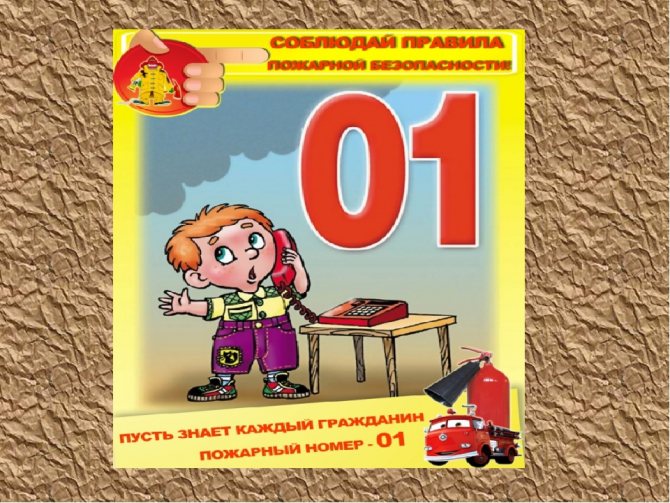
Call rescuers at number 01
During the game, children need to be taught composure. When a fire occurs, they often panic and rush to hide in a safer place - in a closet, under a bed, etc. During the game, preschoolers learn to act and get out of a dangerous place together.
Rules of behavior in nature for preschoolers
You can consolidate your knowledge with each of the children: in turn, they will have to depict or tell what to do if a fire starts in their house. The rest of the children learn from the example of others, and together with the teacher they sort out mistakes.
Note! Through play, the child learns the importance of remaining calm and disciplined.
It is also important to make it clear that in emergency situations the emergency phone number does not immediately come to mind, so you should keep a list of emergency numbers nearby. This could be notes on your phone, a piece of paper in a notebook, a bookmark in a book, etc.
To better perceive information, the game uses special props (toy phones, painted fire) or even an entire scene in the form of a room in which it looks like a fire has started.
Preparatory group. Senior preschool age. Children 6-7 years old
Summary of a lesson with children 6–7 years old “History of firefighting” Topic: “History of firefighting ”
Age of participants: children from 6 to 7 years old Purpose: Development of cognitive activity of children in the preparatory group, consolidation of children’s knowledge about work, familiarization with the history of the development of
fire protection .
Objectives: Developmental: • develop the ability to use... Photo report from a lesson on the world around us in the preparatory group “Safety rules: on ice, in case of fire”
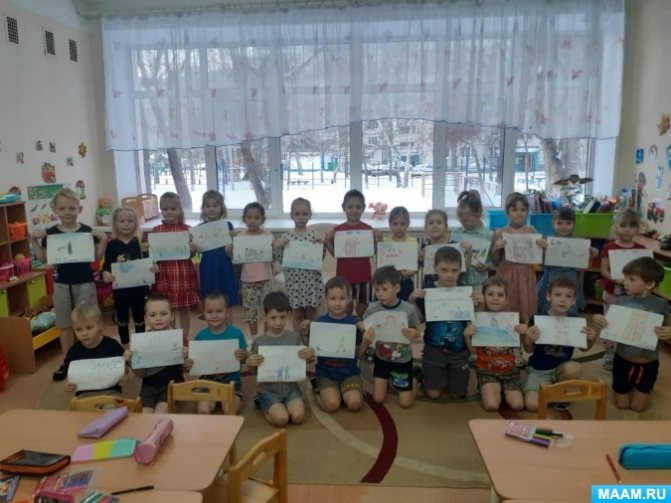
repeated the
safety on ice near water bodies in the autumn-winter period. Remember the rule: “You can’t go on the ice!”
We remembered that ice also poses a huge danger. although the kids are very happy that they can slide on...
Presentation for kindergarten
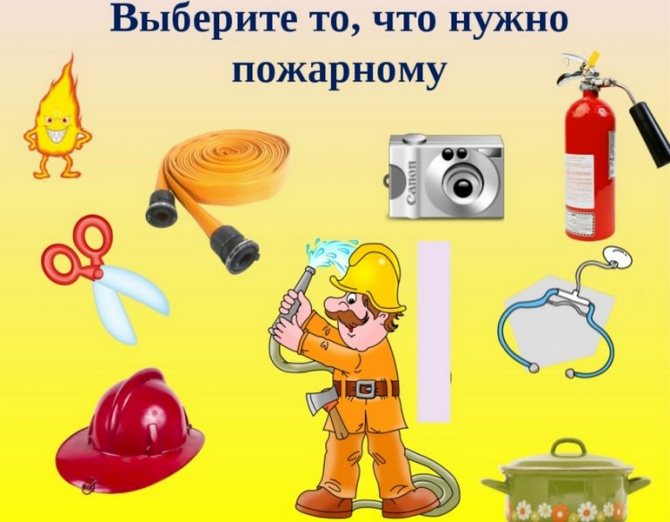
Material from the presentation
If possible, a presentation with an audio story, children's songs, cartoons and pre-acted scenes is prepared for preschoolers. This makes it much easier to provide information.
Children must understand that they should not play with fire, and in times of danger they should listen to the teacher. Every child should learn to be calm and not be afraid to call for help and help others. A well-conducted conversation will teach children fire safety rules on the street and at home.

